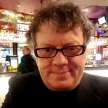
John Braine (1922–1986), was the author of Room at the Top, and many other works, and he was one of the so-called angry young men of the post-war era of English literature. He also wrote a book called Writing a Novel, a copy of which I picked up for 25 pence in a book sale at my local library many years ago. While I never went on to accomplish what is alluded to in the title of that book, I did pick up some valuable advice within its pages.
The most useful piece of information I gleaned from Writing a Novel is that when creating imagery on the page, it pays to discern between what is quick, and what is dead.
Quick: an archaic word for alive
Before we go any further, let me say that quick is an archaic word for alive, as exemplified in the word quicksilver for mercury. So basically, we are separating the dead from what is living. Since I started applying this technique to my writing, I have received plaudits from readers on my use of imagery, thanks in part to what I learned in Mr Braine's book.
And yet, it is another writer, D H Lawrence (1885–1930), whom Braine quotes in the chapter titled The Quick and the Dead. Here's what he said;
"We have to choose between the quick and the dead. The quick is the God Flame, in everything. And the dead is dead. In this room where I write, there is a little table that is dead: it doesn't even weakly exist. And there is a ridiculous little iron stove, which for some unknown reason is quick. And there is an iron wardrobe trunk, which for some more mysterious reason is quick. And there are several books, whose mere corpus is dead, utterly dead and non-existent. And there is a sleeping cat, very quick. And a glass lamp, alas, is dead.
What makes the difference? Quien sabe! But difference there is, and I know it."
What is meant by the quick and the dead?
Very loosely, sorting the quick from the dead in writing is to use only words and phrases that add to the image you are trying to create; things that belong, and to ignore those that do nothing. To demonstrate the technique, I shall give an example from my own writing, and how I applied it.
I wrote a story about a middle-aged couple who had met in the smoking area of a bar. In the early hours, they walk through the streets towards the home of the male half, where more drinking is to take place. At the front door, the man fishes a key from his pocket.
What is behind that front door?
It's been raining, so I could have them wipe their feet on a doormat.
Perhaps I could have the man stoop to pick up some mail that had been delivered.
There could be a bicycle in the passage that had to be squeezed past.
The man could remove his coat, and hang it on a row of hooks in the passage.
There could be a smell of stale cooking, or a cat litter tray that needed replenishing.
Those are all possibilities that I mulled over as I tried to decide on what to reveal to the reader when the front door was opened. But, I wanted to paint an image of squalor, so all of the suggestions above are dead (apart from maybe the cat litter tray), in that they would do nothing to add to the air of impoverishment I wanted to create. Here's what I opted for.
Vic swayed as he fumbled in his trouser pocket for the front door key. The neck of a brown ale bottle protruded from each of his coat pockets, and Sally, who stood behind him, gripped a third bottle. With a muted cry of triumph, Vic pulled out the key, which he held aloft, before inserting into the lock.
"There's no bulb in the passage," he said, quietly. "You wait here till I put the kitchen light on, so you can see your way."
He unlocked the door and walked down the dark passage, his boots clumping on bare floorboards. When a dim glow illuminated the bottom end of the passage, Sally entered, and closed the front door.
The lack of a light bulb and the bare floorboards convey precisely the sort of image I wanted to create, and so they are both quick.

To demonstrate further, we go into the kitchen, which has enough dead to fill a graveyard. This is because, naturally, a kitchen has many appliances, utensils and other items, such as seating. Sticking with the theme of squalor, here's a list of what didn't make the cut.
Electric cooker
Kettle
Kitchen scales
Microwave oven
Sink with draining board
Waste bin
Framed poster on the wall
Curtains
Pots and pans
Vegetable rack
Utensils hanging from hooks
Clock
I made that list from a scan of my own kitchen, and every item on it is dead. Here is how I described the kitchen in the piece. I hasten to add that the following is most definitely not taken from my own kitchen.
The kitchen was a squalid spectacle, lit by a bare light bulb of low wattage.
In the centre there stood a square table, on which reposed a salt cellar, ketchup bottle and vinegar shaker; the triumvirate of seasoning for any man living within close proximity of a fish and chip shop. Next to those lay an ashtray, almost overflowing with many white dog-ends of hand-rolled cigarettes.
Vic put the beer bottles on the table, and Sally stood hers alongside them. She sat down on one of two wooden chairs that were at opposite sides of the table. Vic switched on one bar of an electric fire, but he and Sally kept their coats on.
The impoverishment is brought to life by the bare light bulb, the description of the table, the economy of only putting on one bar of the electric fire, and in the characters keeping their coats on.
So again, by dismissing the dead, and only using what is quick, I managed to create the image of a man who lives a rather spartan life.
The dead comes alive
Of course, what is dead in one setting may well be quick in another. For example, the framed poster on the wall in the list above is dead, but it could be quick in another scenario.
If, say, the kitchen belonged to a radical student who was preparing to go on a protest march, then the poster on the wall could become a print of an old CNT poster from the Spanish Civil War. That would be very much alive, as it shows the reader the political leaning of the protagonist. So it is worth exploring all angles when setting a scene in order to pull out small pieces of information that could add to the image you are trying to create.
These days, I have an instinctive feel for what is quick and what is dead, to the benefit of my writing. It is a simple technique to adopt, and one which can make mental imagery all the more vivid.
About the Creator
Joe Young
Blogger and freelance writer from the north-east coast of England






Comments
There are no comments for this story
Be the first to respond and start the conversation.